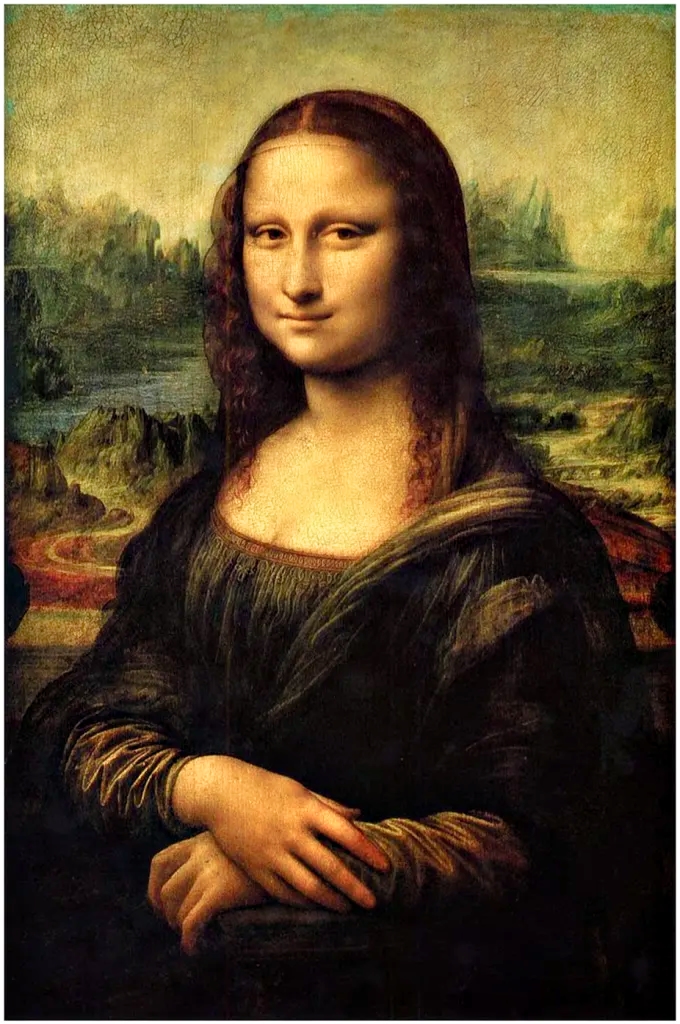In the vast realm of art, where creativity knows no bounds and expression transcends language, there exists a select group of masterpieces that have achieved unparalleled renown. Among them, one painting stands as a beacon of intrigue, captivating the imaginations of millions around the globe with its enigmatic allure: Leonardo da Vinci’s “Mona Lisa.”
Determining the “most famous” painting is subjective and can vary depending on different factors like cultural significance, historical context, and personal preference. However, some paintings are widely recognized and celebrated across the globe.
Leonardo da Vinci’s “Mona Lisa” is often considered one of the most famous paintings due to its enigmatic smile and the mystery surrounding the identity of the subject.
Vincent van Gogh’s “Starry Night” is another iconic work that captivates viewers with its swirling sky and bold colors, representing the artist’s emotional turmoil.
Other contenders for the title of “most famous painting” include “The Scream” by Edvard Munch, “The Last Supper” by Leonardo da Vinci, and “Girl with a Pearl Earring” by Johannes Vermeer, among others.

The Mona Lisa: A Portrait of Intrigue
Commissioned in the early 16th century by the Florentine merchant Francesco del Giocondo, the “Mona Lisa” is shrouded in mystery, from the identity of its subject to the intentions of its creator. Leonardo da Vinci, a polymath of unparalleled genius, infused this portrait with layers of symbolism and subtlety, elevating it beyond a mere depiction of a woman.
Unveiling the Enigmatic Smile
Central to the mystique of the “Mona Lisa” is the enigmatic smile adorning the subject’s lips. Is it a smirk of secret knowledge or a reflection of inner contentment? Countless interpretations have been offered, yet the truth remains elusive, inviting viewers to ponder its significance.
The Gaze that Transcends Time
Equally mesmerizing is the gaze of the Mona Lisa, which seems to follow viewers wherever they stand. Leonardo’s mastery of perspective and light imbues the painting with a sense of life, as if the subject is engaged in a silent dialogue with each observer, across centuries and continents.
The Landscape of the Unknown
Behind the enigmatic figure lies a landscape that further fuels speculation. The ethereal quality of the background, with its misty hills and winding rivers, hints at a world beyond the frame, inviting viewers to venture into the unknown realms of imagination.
The Legacy of the “Mona Lisa”
Beyond its aesthetic appeal, the “Mona Lisa” holds a prominent place in the annals of art history, influencing generations of artists and captivating the public imagination for centuries. Its iconic status has elevated it to a cultural symbol, synonymous with the timeless pursuit of beauty and the insatiable quest for knowledge.
Cultural Impact and Influence
From parodies to pop culture references, the “Mona Lisa” has permeated every facet of society, inspiring countless reinterpretations and tributes. Its image adorns everything from coffee mugs to T-shirts, a testament to its enduring relevance in popular culture.
Theft, Scandal, and Intrigue
The painting’s journey through history has been fraught with drama, including thefts, vandalism, and controversies surrounding its provenance. In 1911, it was famously stolen from the Louvre Museum, sparking a global manhunt and catapulting the “Mona Lisa” to even greater fame upon its recovery.
Endless Speculation and Analysis
Despite centuries of scrutiny, the “Mona Lisa” continues to defy definitive interpretation, inviting scholars and enthusiasts alike to unravel its mysteries. From scientific studies of its composition to psychological analyses of its subject’s demeanor, the painting remains a rich source of inquiry and debate.
Conclusion: A Masterpiece Beyond Compare
In the realm of art, where beauty is subjective and meaning is fluid, the “Mona Lisa” reigns supreme as a testament to the enduring power of creativity and the boundless depths of human imagination. Its enigmatic smile and piercing gaze serve as a reminder that true greatness transcends time, inviting us to contemplate the mysteries of existence and the essence of what it means to be human.
Here’s a list of some of the most famous classical paintings in art history:
- Mona Lisa by Leonardo da Vinci
- The Last Supper by Leonardo da Vinci
- The Starry Night by Vincent van Gogh
- The Creation of Adam by Michelangelo
- The Scream by Edvard Munch
- Guernica by Pablo Picasso
- Girl with a Pearl Earring by Johannes Vermeer
- The Persistence of Memory by Salvador Dalí
- The Night Watch by Rembrandt van Rijn
- The Birth of Venus by Sandro Botticelli
- The Garden of Earthly Delights by Hieronymus Bosch
- The School of Athens by Raphael
- The Arnolfini Portrait by Jan van Eyck
- Las Meninas by Diego Velázquez
- Whistler’s Mother by James McNeill Whistler

